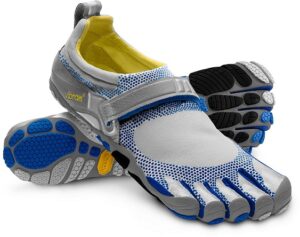
Many runners seek help from a chiropractor for running injuries. Some seem to get endless injuries whilst others do not. Is barefoot running the answer? In this edition of the blog I look at the evidence base for and against barefoot running.
Barefoot running is simply running in thin soled shoes (or without shoes at all!). Barefoot running turns the normal runner from a heel strike into a forefoot strike and it is argued that this running style can decrease injuries. Supporters of barefoot running argue that we have evolved to be able to walk and run long distances barefoot as a survival mechanism and that by wearing footwear we are weakening our intrinsic foot muscles and diminishing proprioception. Weak foot muscles they say can lead to increased injury rates. But is there any evidence that it works?!
Yes and no. Rates of injury amongst runners have remained almost unchanged since the 1970’s despite the massive development in running shoe technology. Today’s running shoes are designed with increased heel cushioning and arch support and a whole host of other very complicated features that supposedly lessen the impact as our foot strikes the ground. If you are thinking of trying barefoot running, consider the following:
1) Not everybody who wears barefoot running shoes runs in the same way. A significant number of runners (around 25{8c34c0d03372d798e22443fa1cd79a4c0c458739bec8c1532104b8390ef42220}) still run in a heel strike pattern as if they were wearing conventional running shoes.
2) We know that running style changes as fatigue sets in but the studies have not looked at barefoot running biomechanics over longer distances.
So the jury is out but what can be said is that the advent of barefoot running has created huge sales in footwear and a massive new industry has evolved. What is important is that if you do try barefoot running then it is paramount that you make a gradual transition. There is a greatly increased risk of injury on the initial stages of barefoot running so you must give your body time to adapt to the new running technique. Initially wear barefoot shoes for just walking and then for short periods running, gradually building the time and distance.
Am I a barefoot runner?
No! I like to think that regular chiropractic treatment and good core stability help to keep good form whilst running. There are also other ways to try and build intrinsic foot strength such as multi-direction lunges and single leg squats. So if you are a runner with persistent lower limb injuries then weigh up the evidence and decide if it is worth a try. Personally, I’d rather suggest exercises and an individual rehab program alongside chiropractic care.
Blog author Alison Eaves. Alison is a qualified chiropractor working in Leeds. Call Revive Chiropractic on 07828 686026 to book an appointment with Alison.

